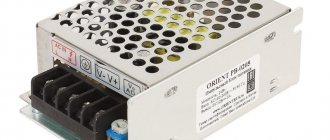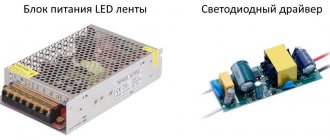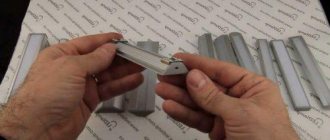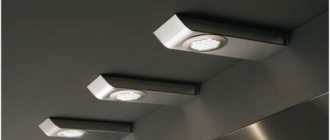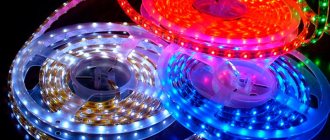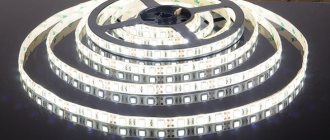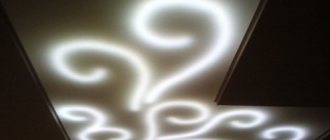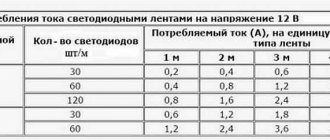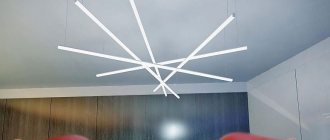LED strip is one of the types of LED lamps, made in the form of a flexible plastic base with an adhesive layer on the back side and LEDs located on it.
It is used for decorative interior lighting, and also as an alternative to the main lighting source. Supplied in plastic spools. The length of the reel is 5 meters. The tape is a single copper board on which resistors and LEDs are located. These five meters consist of individual segments of 5 cm each.
For example, an SMD3528 tape has 1 resistor and 3 LEDs on such a segment. The SMD5050 strip has its own resistor for each LED. Along the edges of the segment there are cut lines and places for soldering. Thus, if necessary, the tape can be shortened only by a length that is a multiple of the segment length.
The copper base of the LED strip is actually the same wires, only in a flat design. Their cross-section is designed for a current capable of powering an area of no more than 5 m. Extending the tape yourself may lead to its failure.
Types of LED strips
LED strips come in several types:
- monochrome or monochrome
- colored or RGB=Red-Green-Blue (red-blue-green)
You can distinguish one-color from RGB by the number of soldered wires. There are only two of them on monochrome, and four on color.
At the same time, to connect a single-color strip, you only need a power supply, and for an RGB strip, a controller is also required.
- open
- protected from moisture
They are also divided according to the size of the LEDs and the method of their application. The most common are:
- SMD3528
- SMD5050
Less popular:
- SMD2835
- SMD5630 (5730)
What is SMD and how does it stand for? SMD from English Surface Mounted Device - surface mount device. That is, the LED is soldered to the substrate on top.
The numbers after SMD indicate the size of the LED in millimeters - its length and width.
Features of choice
The main requirements when selecting and designing an appropriate product are technical and physical indicators. This list includes:
— Length of LED strip. When purchasing an LED device, you need to decide in advance on the required length. After purchase, it will be possible to cut only along the corresponding lines separating the three diodes; — LED strip width. Essentially, this is a narrow product with: 8, 10, 10.2 or more mm. Depends on security and type: open or closed; - Thickness. This parameter also affects the possibility of correct installation. Dimensions range from 2.4 mm to 5.5. The protective coating affects the thickness and ability to operate in certain conditions.
Small dimensions affect installation in hard-to-reach places and areas where only a certain size of tape is required. The choice is also made according to power, where 12V tape is considered popular.
SMD 3528 tape
This type has small LEDs 3.5mm * 2.8mm. The brightness of such a diode is only 4-6 lumens. Tape width 8mm. This type is used exclusively for decorative lighting.
It does not blind your eyes and, due to its low power, allows you to save on the purchase of powerful power supplies.
SMD3528 is available in monochrome colors and is not able to change its color during operation.
How to connect an RGB strip up to 5 meters using a 12V power supply
In addition to the tape in the diagram, we see two other electronic devices - a power supply and an RGB controller. It must be remembered that the power of each device should be 25-30 percent greater than the power consumed by the tape itself. If we look at the power tables of any tape manufacturer, the most popular SMD 5050 out of 60 pieces of 12V RGB tapes consume 72 W. Let's carry out some simple manipulations with numbers and find that the power supply for the tape should have the following power: 72+30%=93.6 W. Manufacturers do not produce blocks with such power. The closest one is 100 W. It will be enough for us.
SMD 5050 tape
SMD5050 has LEDs measuring 5mm by 5mm. Such LEDs can already replace the main lighting, since the power of just one element here is 11-25 lumens.
This will give a luminous flux equal to a 60 watt incandescent light bulb. Actually, the consumption of SMD5050 is only 15 W. Tape width - 10mm.
It is about 3 times brighter than SMD3528. One of its main advantages is the ability to change colors under the control of an RGB controller.
SMD 2835 tape
SMD2835 produces about 50 lumens per chip. It has a high price. Width - 8mm.
High light output also has a negative side - heating the surface. It is prohibited to use such tape without good heat dissipation.
Use an aluminum profile for it, preferably with a matte screen. It will diffuse the light, smoothing out the glare effect.
LEDs 2835 and 3528 are very similar to each other, how can you quickly distinguish them? The cheap 3528 chip is tall, while the expensive and bright SMD 2835 has a low profile for better cooling and heat dissipation.
Connection
LED models SMD 3528 or 5050 are connected to the controller to control the light according to the same scheme as when connecting a 12-volt strip to a 220-volt network. In this case, you should connect a power supply that will make it possible to reduce the voltage to 12 volts. This diagram is shown below.
Connection diagram
Cut location
The products are 5 meters long in a skein. Therefore, very often they should be cut to attach, for example, to furniture. Subsequently, these pieces are either connected to each other, or attached to a power supply (for connection to a 220-volt network) or a controller. Therefore, we will begin our consideration of the connection diagram with the procedure for preparing the light source. The connection diagram is implemented as follows:
- measure the required section of the tape and cut it in a strictly designated place;
Note! The length of the required piece of product is determined by where you intend to attach it.
Soldered wires
- after cutting the wires that should be connected to the light source, you need to strip them at the ends;
- Wires should be connected to the contact pads that appear at the end of the tape. To do this, using a soldering iron and a soldering kit (rosin and tin), solder the wires to the contact pads;
- after the wires, in strict accordance with their sign (“-” and “+”), have been soldered to the contact pads, we process the working surface;
- then contact insulation is necessary. If the insulation is poor, there is a risk of a short circuit, and the lighting device will continue to work incorrectly and short-lived.
Separately, it is worth noting that the easiest way to connect the wires is to use a special LED connector. This is the so-called mechanical method.
LED connector
It is enough to simply attach such a connector to the contact pads (the contacts of both products must match) and slam the lid. That's it, no need to work with rosin and tin.
Note! Using an LED connector is an expensive proposition. For the price, one such contact will cost you about half a meter of LED strip. And it itself is not the cheapest purchase.
Therefore, the old method of soldering contacts remains more than in demand and relevant today.
SMD tape 5630 (5730)
The most powerful chip is 5630 (5730). It has a light output of 60 lumens.
It is even more demanding when it comes to cooling. It is mainly used for illuminating expensive interiors and in the windows of inexpensive shops and boutiques.
Comparison of technical characteristics of LED strips SMD3528, 5050, 5630, 5730 summarized in one table:
Main conclusions
The first condition is to choose a high-quality LED strip - it will be 30-50% brighter than a cheap one and will last (at least) 5 years. When choosing a cheap product, it is difficult to calculate the parameters of the power supply, since the parameters declared by the manufacturer most often do not correspond to the real ones. If the lighting system is completely changed, it is advisable to entrust the calculations to a specialist.
Previous
LEDsT6 or U2 LED, which is better in terms of technical characteristics
Next
LEDsTypes and diagram of a device for testing LEDs
Power and brightness of the tape
Everything is simple here, the more LEDs mounted on the strip and the larger they are, the greater its power. The lowest power is SMD 3528 with 60 diodes. Its power is only 4.8W.
The brightness of an LED strip is proportional to its power. The more powerful it is, the brighter it will shine. Just don’t confuse the dependence on quantity here, and always pay attention to the size of the LEDs themselves.
A strip with 30 elements can shine much brighter than one with 60.
How LED strips are labeled
The adoption of a unified labeling system for LED strips is long overdue, but manufacturers of lighting equipment are in no hurry to reach an agreement among themselves. Therefore, there are several different parallel ways to briefly indicate the characteristics of LED strips. The most informative marking looks like RTW 2-5000PGS-12V-DayWhite 2x (3528, 600 LED, W). The decoding is given in the table.
| RTW | Sealing tape with front glow |
| 2 | Factory series |
| 5000 | Total coil length in mm |
| P.G.S. | Sealing method (silicone shell filled with sealant) |
| 12V | Supply voltage |
| DayWhite | Glow color |
| 2x | Double installation density of light-emitting elements |
| 3528 | LED form factor |
| 600 LED | Total LED quantity |
| W | Backing color (W-white) |
In this system there was no place for at least two important parameters, without which the choice of a lighting device is difficult:
- energy consumption of one meter of tape (it can only be roughly estimated by the standard size of the LEDs used and the density of their installation);
- degree of protection (here you can also make a rough estimate based on the sealing method).
But this marking seems most suitable for adoption as a standard, or at least the basis for one.
The video block will complement the above.
Degree of protection
The degree of protection of the tape is indicated by two Latin letters - “IP” and two numbers after them.
- tapes without protection - IP20
It is not protected from moisture, splashes and is very poorly protected from mechanical influences. Soldering points, contacts, etc. are exposed. Some manufacturers specify IP33 in their documents, but this can also be attributed to products without protection.
If moisture gets on such a tape, a short circuit may occur and it will burn out.
- tapes with IP65 or IP54 protection
A protective compound is applied to it on the upper side. Among experts it is called silicone tape. In fact, it is not silicone, but an epoxy coating.
This LED strip is afraid of frost, because its protection at subzero temperatures simply hardens and becomes hard and brittle.
- tapes with IP67 protection
This is already a completely sealed product. This tape can even be installed outdoors. It is placed in a silicone case and is not afraid of moisture and rain.
- maximum protection IP68
This tape is placed in a U-shaped silicone profile and filled with epoxy compound on top. It can even withstand being placed in water. Often used for lighting in fountains or in the bathroom.
Having familiarized yourself with all the characteristics, the next time you go to the store, when you ask the seller: “What kind of LED strip do you need?” you must answer boldly and knowledgeably:
“I need an SMD 5050 LED strip with 60 diodes, with a degree of protection of IP65 and so that its luminous flux is at least 1200 lumens.”
How to choose depending on the type of room
When choosing lighting for a room, you should take into account simple recommendations. There is no need to use the same lighting everywhere, since different rooms have different lighting requirements and conditions of use. Remember the following:
- For a living room or hall, you should choose a powerful multi-color tape with the ability to adjust modes and brightness. A 24 V option is better.
- In the kitchen, a waterproof variety is used that can withstand splashes. When illuminating the work area, use dim lighting; for general illumination, choose more powerful options.
- General lighting in all rooms without the use of chandeliers and spotlights should be made from a single-color bright strip. For uniform light, you can use special diffusers.
- In bathrooms and toilets, it is important to choose the right brightness. Use options with water protection of at least IP44, since humidity often increases there.
- In children's rooms, LED strips are often used to decorate the interior. But with its help you can illuminate the playing area or create dim light for the night period, reducing the brightness to a minimum.
An example of using LED strip in the living room.
If you need to make general and decorative lighting with LED strips, it’s easier to use two options. 24 V for standard light, and 12 V for creating a variety of effects.
From the video you will find out what LED strips are available on Aliexpress
Differences between cheap and expensive LED strips
The most “blurred” characteristic, but the most important for you, is the quality class of the tape. Why do the same copies with the same number of LEDs, power, and the same degree of moisture protection cost completely different money?
How to distinguish a good tape from a poor one and what is the difference? To understand this, you need to know what the LED strip consists of.
Its three main components:
- substrate or flexible printed circuit board
- the LEDs themselves
- resistors
Rating of the best tape manufacturers
You should not buy products from unknown manufacturers, as they do not last long and often the stated characteristics do not correspond to the actual ones. It is better to choose one of the trusted brands with a good reputation:
- Elektrostandard. A manufacturer that has all types of tapes with different classes of moisture protection. Prices depend on the number of LEDs per meter and the type of product.
- Gauss. A company that makes quality tapes. The products have a guarantee, it is easy to choose the right solution for any room.
- Feron. It produces 12 and 24 V options, the prices are not very high, but the quality is good.
- Jazzway. The products do not stand out from the general range, but are not inferior to most analogues in quality. Prices are average.
- Navigator makes inexpensive tapes for different voltages. The quality is not bad, although there are some complaints due to sloppy soldering and the fragility of the base.
- LEDcraft. A Russian manufacturer whose prices are slightly higher than those of Chinese goods, but the quality is better.
The LEDcraft tape burns brightly and lasts a long time.
It is difficult to make an accurate rating of LED strips, since each manufacturer has pros and cons. But if you choose products from the listed brands, problems most likely will not arise.
You need to select an LED strip taking into account the recommendations from the review and find products from a well-known manufacturer. The main thing is to understand the features of use, calculate the required power and install the lighting correctly.
Substrate
Despite the similarity, standard-class tapes and premium tapes differ in everything, starting with the backing. In the premium version, it contains much more copper. This tape is simply thicker.
Due to this, its current-conducting ability is much higher, plus it removes heat faster. Unfortunately, you can’t feel this with your hands, but an electronic caliper or micrometer will help determine the difference in the thickness of a cheap and expensive tape.
Advantages and disadvantages compared to 12 V tape
LED strips for connection to a 220 V power supply have the following advantages:
- Easy to connect. Unlike 12 V models, they do not need an expensive power supply, just an outlet. Fewer elements in the circuit means more reliability.
- Due to the previous point, the cost of the finished structure is reduced.
Otherwise, the advantages are the same as those of low-voltage analogues. But there are two significant drawbacks:
- 220 volts is a high voltage that is dangerous for humans; you should not use such tape in a swimming pool.
- Due to the pulsation of the 220 V light flux, the tape cannot be used as a lighting source.
In addition, if there is a surge or increased voltage in the 220 V supply network, the tape, unlike a low-voltage one, will quickly fail.
LED difference
The LED itself consists of a housing in which emitting crystal chips are placed. The whole thing is filled with compound on top. The chips in cheap and expensive tapes are different.
What are the differences?
- in size
In inexpensive tapes, they are smaller in size and, accordingly, produce a lower luminous flux.
- conductive thread material
For high-quality ribbons they are gold. In standard versions they are made of alloys. Over time, under the influence of a phosphor or compound, the alloy threads are destroyed. Therefore, the service life of the LED itself is shorter.
- quality of phosphor filling
For the elite class, it has less impact on the chips themselves and their contact does not affect the service life of the LED.
- difference in chips
The so-called binning. This is when neighboring LEDs, due to different crystals, can shine with different fluxes and shades.
How can you see all this clearly in the store? Unfortunately, this cannot be done visually without applying voltage. But by turning on the tapes in parallel, one next to the other, you can see the difference.
The premium LED will appear to be slightly larger. Actually this is not true. Both may have SMD3528, but the high-quality version will simply have a larger chip. Because of this, this impression is created.
But it’s best to look not at the LEDs themselves, but at the surface illuminated by them. LEDs from different companies may have different scattering angles (according to the standard it should be 120 degrees). A chip with a smaller angle (90-100 degrees) will visually seem much brighter to you, although in fact this will not be the case.
Points to pay attention to
Color shade and number of colors
Choosing an LED strip begins with determining the color of its glow. Modern single-color LEDs are produced with one of four crystal glows: white (W), blue (B), red (R) or green (G). Other colors are obtained by applying a special phosphor to the crystal or by installing several LEDs of different colors in the crystal at once, which operate simultaneously. Thus, a single-color LED strip can be produced with any color of luminous flux. In specialized stores you can even choose specimens with an orange, crimson, purple or turquoise glow. But white light LED strips are in great demand, which are divided according to color temperature into three groups: warm, neutral and cold glow. You can accurately select the desired option only visually, comparing several samples.
In addition to single-color LED strips, multi-color analogs are available for sale, marked with RGB symbols. They contain LEDs consisting of three crystals: red, green, and blue. As a result of the simultaneous glow of several crystals with different intensities, any light shade can be obtained. Typically, such lines are chosen for decorative lighting. It is worth noting that using LEDs R, G and B it is impossible to obtain pure white light. If you need a multi-color LED strip with the ability to glow with white light, then you should choose a product marked WRGB. The LED chips of the WRGB strip have built-in additional white crystals.
Light flow
Today in retail stores you can purchase a piece of any length. In this case, the density of SMD elements in one linear meter of tape should be taken into account. In a single-row strip, the density of LEDs is a multiple of 30, and in a double-density strip - 60. The maximum number of installed LED chips in 1 meter of a product is 120. When turned on, such a segment resembles a solid luminous strip. Also on sale you can find double, triple and even quadruple width tape with LED elements placed in several rows.
Particular attention should be paid to the size of the LED chip. Initially, two chips were most widely used: 3528 with one crystal and a standard size of 3.5x2.8 mm and 5050 with three crystals and a total chip surface area of 5.0x5.0 mm. Later, the LED industry introduced new types, among which on the Russian market there are standard sizes 5060, 5630 and 5730. The size of the element directly determines the magnitude of the luminous flux - the amount of emitted light energy per unit of time. In theory, the luminous flux for LED SMD 3528 is 5 Lm, for LED SMD 5050–15 Lm. Multiplying these values by the corresponding number of elements in the segment, we obtain the total brightness. For example, the luminous flux of a five-meter tape 3528–60 will be about 1500 Lm.
Supply voltage and power
In order for the LED strip to start glowing, it must be supplied with suitable power (usually 12 V). For these purposes, 220-volt power converters, called drivers, adapters or power supplies, are used. An important parameter of any power supply is the power it can provide to the load. The power of the converter is selected based on the power consumption of one meter of LED strip, which is indicated on the packaging. If there is no documentation, you can calculate it yourself. For example, every three 3528 LEDs connected in series consume 20 mA of current and 0.24 W of power. Multiplying these values by the number of triads, we get the total value. For frame size 5050, a current of 60 mA and a power of 0.72 W should be specified. Thus, a meter piece of SMD 3528–60 tape consumes 4.8 W, and SMD 5050–60 – 14.4 W. Below is a table of the power of the most common LED strips.
| SMD LED type | Number of LED chips per 1 meter, pieces | Power consumption 1 meter, W |
| 3528 | 60 | 4,8 |
| 3528 | 120 | 9,6 |
| 3528 | 240 (double row) | 19,2 |
| 5050 | 30 | 7,2 |
| 5050 | 60 | 14,4 |
In order for the power supply to operate stably and without overheating, it needs to be provided with a safety margin. To do this, the calculated power is multiplied by a factor of 1.2. The RGB strip is connected to the driver through a special controller with pins for each color. The organization of lighting from strips more than 10 meters long requires additional recharge and matching units. Otherwise, the edge farthest from the power source will not provide the rated luminous flux. This negative phenomenon occurs due to the voltage drop on the current-carrying tracks, which reaches 0.4 V/m.
Degree of protection
The correct choice of LED strip is impossible without taking into account the degree of protection (IP - Ingress Protection). The designation consists of two numbers, the first of which indicates protection against the ingress of solids, and the second - protection against the ingress of liquid into the product. Some manufacturers, instead of the generally accepted designation, indicate their own abbreviation, the explanation of which is on the manufacturer’s website.
LED strips of class IP65 - IP68 have better protection from moisture, but worse heat dissipation due to the silicone shell. They should be chosen only when clearly necessary, since they have a significantly higher price due to the additional silicone coating.
Build quality
The quality of LED strips is determined solely by the manufacturer. Two points are worth noting here: the build quality of the final product and the quality of the components of the tape itself. The second is impossible for the average buyer to determine, since SMD components are very small. The problem is that the robotic system cuts and installs a smaller crystal into the LED, which leads to its gradual overheating and loss of brightness. As for assembling the final product, it’s easier here. Low-quality LED strips have unevenly soldered SMD elements and, as a rule, there are no special cut marks on them.
When making a choice in favor of low-quality Chinese products, you need to take into account three nuances:
- the real value of the luminous flux will be less than the theoretical one;
- the service life of such a product may vary less;
- The adhesive base will lose its properties over time.
Adhesive base
All tapes have an adhesive backing on the back. For Premium it is Scotch 3M. Moreover, there should be not only one 3M inscription, but also markings in the form of separate numbers.
However, no matter how high-quality it is, over time this tape also comes off. Imagine if you have all this stuff hidden behind a suspended ceiling?
Therefore, professionals advise using heat-conducting glue for gluing LED strips or additionally supporting it at several points with small zip ties.
Where is it used?
Controller and remote control
Many people often use LED strips to control the lighting system and create a unique play of light in their home. But for a control system with such a light source to work, additional equipment is required: a controller and a remote control.
Today it is impossible to do without an LED strip in the following situations:
- creating hidden lighting on the ceiling;
- night lighting of billboards and store windows;
- car tuning;
- night lighting at home;
- creating a romantic atmosphere and much more.
Ceiling lighting
All this diversity is based on a wide range of types of such light sources.


